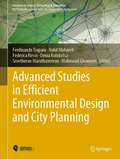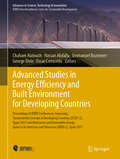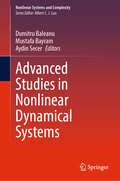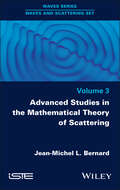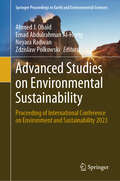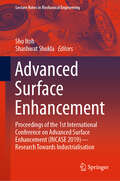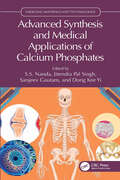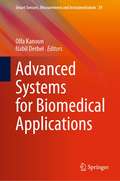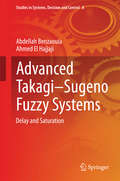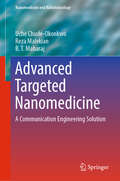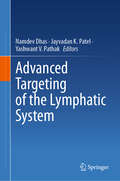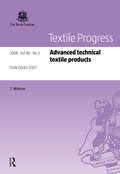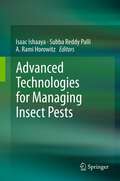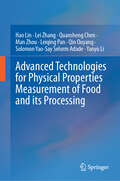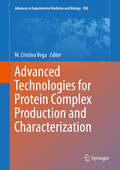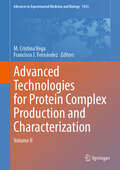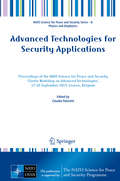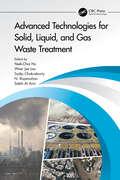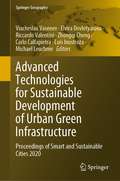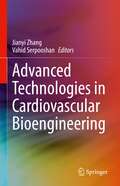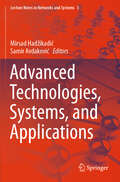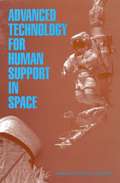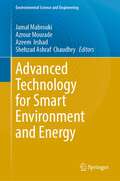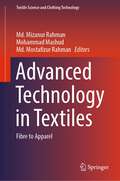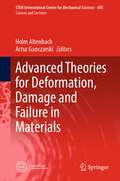- Table View
- List View
Advanced Studies in Efficient Environmental Design and City Planning (Advances in Science, Technology & Innovation)
by Denia Kolokotsa Nabil Mohareb Mahmoud Ghoneem Ferdinando Trapani Federica Rosso Sreetheran MaruthaveeranThis book explains how learning from past mistakes in urban design can help to enhance sustainable cities and how the principles of Green Urbanism can yield more resilient urban settlements. Environmental design is a fundamental principle in shaping cities. However, environmental challenges like increased resource consumption, water degradation and waste-related issues are among the greatest problems now facing humanity – which is why these issues need to be considered with regard to “smart cities,” either for the development of new urban centers or for the transformation of existing cities. The book not only discusses the importance of integrating sustainability principles in the urban design process, but also demonstrates their application to the development of sustainable cities. As such, the book offers essential information and a source of inspiration for all those who want to build more sustainable cities.
Advanced Studies in Energy Efficiency and Built Environment for Developing Countries: Proceedings of IEREK Conferences: Improving Sustainability Concept in Developing Countries (ISCDC-2), Egypt 2017 and Alternative and Renewable Energy Quest in Architecture and Urbanism (AREQ-2), Spain 2017 (Advances in Science, Technology & Innovation)
by Chaham Alalouch Hassan Abdalla Emmanuel Bozonnet George Elvin Oscar CarracedoThis edited volume consists of three parts. It is a culmination of selected research papers presented at the second version of the international conference on Improving Sustainability Concept in Developing Countries (ISCDC) and the second version of the international conference on Alternative and Renewable Energy Quest in Architecture and Urbanism (AREQ), organized by IEREK in Egypt, 2017. It discusses major environmental issues and challenges which threaten our future. These include climate change impact, environmental deterioration, increasing demand for energy and new approaches for alternative renewable energy sources which became a necessity for survival. In addition to addressing the different environmental issues witnessed today, research presented in this book stressed on the need of sustainably shaping buildings and cities using renewable energy sources. Topics included in this book are (1) Resilience in the Built Environment, (2) Design for energy-efficient architecture and (3) Alternative and Renewable Energy Resources Quest in Architecture and Urbanism. The book is of interest to researchers and academicians who continuously aim to update their knowledge in these fields, as well as decision makers needing the enough knowledge to carry out the right decisions towards the benefit of the environment and society.
Advanced Studies in Nonlinear Dynamical Systems (Nonlinear Systems and Complexity #41)
by Dumitru Baleanu Mustafa Bayram Aydin SecerThis book is a compilation of select chapter from the 2023 International Conference on Nonlinear Science and Complexity. It presents recent advancements, discoveries, and ongoing research in various facets of nonlinear science and complexity. The book covers a broad scope of topics, including nonlinear dynamical systems, complex systems, quantum sensing, and mathematical approaches in biological and economic models. Key subspecialties addressed include nonlinear differential equations, modeling of nonlinear processes in diverse fields such as biology and economics, and innovative computational techniques. Each chapter contributes unique insights into its respective field, providing theoretical analyses, practical applications, and numerical simulations to advance the understanding of complex nonlinear phenomena.
Advanced Studies in the Mathematical Theory of Scattering, Volume 3 (ISTE Invoiced)
by Jean-Michel L. BernardThis book presents a collection of independent mathematical studies, describing the analytical reduction of complex generic problems in the theory of scattering and propagation of electromagnetic waves in the presence of imperfectly conducting objects. Their subjects include: a global method for scattering by a multimode plane; diffraction by an impedance curved wedge; scattering by impedance polygons; advanced properties of spectral functions in frequency and time domains; bianisotropic media and related coupling expressions; and exact and asymptotic reductions of surface radiation integrals. The methods developed here can be qualified as analytical when they lead to exact explicit expressions, or semi-analytical when they drastically reduce the mathematical complexity of studied problems. Therefore, they can be used in mathematical physics and engineering to analyse and model, but also in applied mathematics to calculate the scattered fields in electromagnetism for a low computational cost.
Advanced Studies on Environmental Sustainability: Proceeding of International Conference on Environment and Sustainability 2023 (Springer Proceedings in Earth and Environmental Sciences)
by Zdzislaw Polkowski Ahmed J. Obaid Emad Abdulrahman Al-Heety Neyara RadwanThis proceedings book of ICES 2023 presents the most recent studies on environmental sciences and environmental sustainability, which contributes to the resolution of environmental issues (air pollution, water pollution, soil pollution, noise pollution, thermal pollution, radioactive pollution, light pollution, and global warming). The discharge of environmental pollutants from industrial, commercial, residential, and sensible locations must be handled with care, since it may harm the air, water, and land if not adequately treated. As a result of the enormous volume of wastewater and environmental pollution generated daily, the majority of designs and developments of wastewater technologies and environmental treatment were unable to handle the load. This is a threat to sustainable growth, and it must be resolved in a precise, dependable, urgent, and timely manner. Sustainable creative and technical transfer approaches that can be utilized for supporting, operationalizing, and providing sustainable wastewater and environmental treatment solutions are of interest to us. The authors hope that the book covers the possible spectrum of wastewater technologies and environmental treatment up to a high level of environmental protection, clean and green management lessons, identify the barriers to transformational change, and then inform the agenda and initiatives for sustainable development. ICES 2023 is devoted to wastewater technology and environmental treatment, with an emphasis on environmental protection at the highest level. ICES 2023 aims to disseminate current knowledge and sustainable development, share experience and lessons gained, and generate conversation and reflection in order to promote a paradigm shift that is sustainable. With the distribution of sustainable wastewater technology and environmental treatment, the ultimate goal is to bring revolutionary change to sustainable development.
Advanced Surface Enhancement: Proceedings of the 1st International Conference on Advanced Surface Enhancement (INCASE 2019)—Research Towards Industrialisation (Lecture Notes in Mechanical Engineering)
by Sho Itoh Shashwat ShuklaThis book presents the proceedings of the first INCASE conference, organised by ARTC at A*STAR, Singapore. It provides a comprehensive review of recent advances in surface enhancement processes and strategies employed to assess their impact on materials properties and performance. As cyber-physical systems are becoming more and more relevant in manufacturing, it focuses on assessing the readiness of current technologies for future transformations, such as Industry 4.0, identifying the opportunities and challenges, and exploring ways to address them. Written by researchers, practising engineering and industry experts, the book bridges the gap between research and manufacturing, promoting technology adoption in industry and innovative ideas to prepare it for the future.
Advanced Synthesis and Medical Applications of Calcium Phosphates (Emerging Materials and Technologies)
by Dong Kee Yi Jitendra Pal Singh S. S. Nanda Sanjeev GautamCalcium phosphate materials are used in many medical and dental applications. Advanced Synthesis and Medical Applications of Calcium Phosphates covers the structure, chemistry, synthesis, and properties of both natural and synthetic calcium-based biomaterials and details a variety of medical applications. Depicts the latest advances in using calcium phosphates in bone regeneration and tissue engineering Includes the latest generation of regenerative biomaterials with an integrated perspective combining both research and clinical issues Provides an understanding of the clinical targets and requirements for regenerative medicine Detailing fundamentals through applications, this book helps biomaterials researchers to better understand the clinical targets and requirements for use of these materials for optimal synthesis and development.
Advanced Systems for Biomedical Applications (Smart Sensors, Measurement and Instrumentation #39)
by Nabil Derbel Olfa KanounThe book highlights recent developments in the field of biomedical systems covering a wide range of technological aspects, methods, systems and instrumentation techniques for diagnosis, monitoring, treatment, and assistance. Biomedical systems are becoming increasingly important in medicine and in special areas of application such as supporting people with disabilities and under pandemic conditions. They provide a solid basis for supporting people and improving their health care. As such, the book offers a key reference guide about novel medical systems for students, engineers, designers, and technicians.
Advanced Takagi-Sugeno Fuzzy Systems: Delay and Saturation (Studies in Systems, Decision and Control #8)
by Abdellah Benzaouia Ahmed El HajjajiThis monograph puts the reader in touch with a decade's worth of new developments in the field of fuzzy control specifically those of the popular Takagi-Sugeno (T-S) type. New techniques for stabilizing control analysis and design based on multiple Lyapunov functions and linear matrix inequalities (LMIs), are proposed. All the results are illustrated with numerical examples and figures and a rich bibliography is provided for further investigation. Control saturations are taken into account within the fuzzy model. The concept of positive invariance is used to obtain sufficient asymptotic stability conditions for the fuzzy system with constrained control inside a subset of the state space. The authors also consider the non-negativity of the states. This is of practical importance in many chemical, physical and biological processes that involve quantities that have intrinsically constant and non-negative sign: concentration of substances, level of liquids, etc. Results for linear systems are then extended to linear systems with delay. It is shown that LMI techniques can usually handle the new constraint of non-negativity of the states when care is taken to use an adequate Lyapunov function. From these foundations, the following further problems are also treated: · asymptotic stabilization of uncertain T-S fuzzy systems with time-varying delay, focusing on delay-dependent stabilization synthesis based on parallel distributed controller (PDC); · asymptotic stabilization of uncertain T-S fuzzy systems with multiple delays, focusing on delay-dependent stabilization synthesis based on PDC with results obtained under linear programming; · design of delay-independent, observer-based, H-infinity control for T-S fuzzy systems with time varying delay; and · asymptotic stabilization of 2-D T-S fuzzy systems. Advanced Takagi-Sugeno Fuzzy Systems provides researchers and graduate students interested in fuzzy control systems with further approaches based LMI and LP.
Advanced Targeted Nanomedicine: A Communication Engineering Solution (Nanomedicine And Nanotoxicology)
by Uche Chude-Okonkwo Reza Malekian B. T. MaharajThis book presents medical challenges as communication engineering problems. It offers the reader the interesting perspective of exploring and understanding disease pathology from the point of view of communication engineers. Therefore, diseases and their treatments can be addressed using conventional communication paradigms, approaches, tools and devices; thereby ushering in the interdisciplinary research platform termed advanced targeted nanomedicine. The rudimentary framework for advanced targeted nanomedicine is presented and expatiated across the seven chapters of this book.
Advanced Targeting of the Lymphatic System
by Jayvadan K. Patel Yashwant V. Pathak Namdev DhasThis book goes in depth about the lymphatic system and the functions of the lymphatic organs, lymphatic tissues, and lymphatic vessels. The book addresses various types of diseases in which the lymphatic system can act as a targeting site for drug absorption and suggests strategies to treat these different infections of the lymphatic system. This book is intended for academicians who work in fields related to the lymphatic system, novel drug delivery systems, pharmaceutical science, novel-material sciences, as well as professionals in the medical, nursing, or other health care industries.
Advanced Technical Textile Products (Textile Progress)
by T. MatsuoVolume 40.3 of the journal Textiles Progress, this book describes advanced technical textiles products according to the application fields of the fiber materials. Although it does not cover all of the end-uses, the book contains major parts of advanced technical textile products, including products for resources and environmental issues, automobiles, medical and protective uses, information technologies, civil engineering, and electronics textiles.
Advanced Technologies for Managing Insect Pests
by Isaac Ishaaya A. Rami Horowitz Subba Reddy PalliAmong the highlights of this book is the use of novel insecticides acting on a specific site in an insect group and are compatible with natural enemies and the environment. One of such approaches is based on disrupting the activity of biochemical sites acting on transcription factors such as the Helix-Loop-Helix (bHLH) family, anti juvenile hormone (AJH) agents that target JH biosynthetic enzymes, G-protein coupled receptors (GPCR) and bursicon as a target for insect control. Another one is the biotechnology or the genetic approach such as gene silencing (RNA interference) and Bt-crops. Other sections of the book are devoted to the plant's natural products, optical manipulation and the use of nanotechnology for improving insect control methods.
Advanced Technologies for Physical Properties Measurement of Food and its Processing
by Lei Zhang Quansheng Chen Hao Lin Man Zhou Leiqing Pan Qin Ouyang Solomon Yao-Say Adade Yanyu LiThis book provides a comprehensive overview of the physical properties of foods and the cutting-edge technologies employed to measure them. Delving into key topics such as optical, thermal, acoustic, rheological, and textural properties, it provides a detailed examination of principles, measurement methods, and applications in food quality evaluation. While it discusses advanced technologies such as near-infrared spectroscopy, computer vision, spectral imaging, acoustic resonance analysis, electronic noses/tongues/eyes, and multi-sensor data fusion in detail, the book also introduces intelligent equipment design and real-time quality monitoring systems for the food industry, including emerging technologies like 4D printing and terahertz technology. The book also addresses critical questions about the application of these technologies in real-world scenarios, making it a must-read for those seeking to understand and apply the latest advancements in food science. This book is an invaluable resource for undergraduate and graduate students, researchers, and professionals in food science and engineering. It helps readers understand the principles of various non-destructive food quality measurement techniques and applies them to in-situ evaluation and in-field monitoring. It also serves as both a textbook and a reference guide, enabling readers to understand and apply advanced measurement and processing techniques for in-situ evaluation and in-field monitoring. By providing a thorough understanding of the principles and applications of food physical properties, this book ensures that its audience remains at the forefront of technological advancements in the field. The book contains several chapters originally written in the Chinese language. The translation was done with the help of artificial intelligence. A subsequent human revision was done primarily in terms of content.
Advanced Technologies for Protein Complex Production and Characterization (Advances in Experimental Medicine and Biology #896)
by M. Cristina VegaThis book presents advanced expression technologies for the production of protein complexes. Since complexes lie at the heart of modern biology, the expression, purification, and characterization of large amounts of high-quality protein complexes is crucial for the fields of biomedicine, biotechnology, and structural biology. From co-expression in E. coli, yeast, mammalian and insect cells to complex reconstitution from individual subunits, this book offers useful insights and guidance for successful protein expressionists. Across several sections readers will discover existing opportunities for the production of protein complexes in bacterial systems (including membrane proteins and cell-free co-expression), methylotrophic and non-methylotrophic yeasts, protozoa (Leishmania terantolae and Dictyostelium discoideum), baculovirus-infected insect cells, mammalian cells, plants and algae. Complex reconstitution from individually purified subunits or subcomplexes is discussed as a complementary strategy. A last section introduces briefly some of the biophysical and structural characterization techniques for macromolecular complexes using state-of-the-art solution scattering and nuclear magnetic resonance. This work is a guided tour over some of the most powerful and successful protein expression technologies, with a focus on co-expression and high-throughput applications. It is addressed to everyone interested in the production and characterization of macromolecular complexes, from university students who want an accessible description of the major co-expression systems to researchers in biomedicine and the life sciences seeking for an up-to-date survey of available technologies.
Advanced Technologies for Protein Complex Production and Characterization: Volume II (Advances in Experimental Medicine and Biology #1453)
by M. Cristina Vega Francisco J. FernándezThis edited volume discusses the identification, discovery, characterization, structure determination and modeling of multicomponent macromolecular complexes, and as such, it fully complements the first volume (ISBN 978-3-319-27214-6), which targeted methods of recombinant production of protein complexes. This book is divided in 8 sections offering a selection of technologies widely used in the characterization of protein and protein-nucleic acid complexes for different purposes and at different scales. From native electrophoresis methods, that are accessible to any reasonably well-equipped laboratory, to the sophisticated setup required for structure determination by cryo-electron microscopy or X-ray crystallography, this book contains a wide variety of clearly explained analytic and preparative approaches, connected with the production techniques developed on the previous volume. The readers will find an integral connection between this book and the first volume, which ensures a comprehensive and updated discussion of the main topics of the discipline. Taken together, these volumes constitute a cohesive and authoritative source of the research on multicomponent macromolecular complexes. In here, we focus on characterization of protein complexes in the broadest sense, which is not typically covered in other sources. Moreover, all chapters are carefully written by world renowned scientists and active researchers, making this volume ideal, not only as a reference source, but also as a companion book for the daily laboratory work. This book is aimed for a wide range of scientists, from science students to experienced researchers, working on protein and protein-nucleic acid complexes, who need a thorough understanding of protein production and complex characterization.
Advanced Technologies for Security Applications: Proceedings of the NATO Science for Peace and Security 'Cluster Workshop on Advanced Technologies', 17-18 September 2019, Leuven, Belgium (NATO Science for Peace and Security Series B: Physics and Biophysics)
by Claudio PalestiniTechnology has been the spark that ignited NATO’s interest and commitment to scientific advancement during its history. Since its creation, the Science for Peace and Security (SPS) Programme has been instrumental to NATO’s commitment to innovation, science and technological advancement. During the years, SPS has demonstrated a flexible and versatile approach to practical scientific cooperation, and has promoted knowledge-sharing, building capacity, and projected stability outside NATO territory. The priorities addressed by the SPS Programme are aligned with NATO’s strategic objectives, and aim to tackle emerging security challenges that require dynamic adaptation for the prevention and mitigation of risks. By addressing priorities such as advanced technologies, hybrid threats, and counter-terrorism, the Programme deals with new, contemporary challenges. On 17-18 September 2019, the SPS Programme gathered at the KU Leuven University a wide number of researchers from a selection of on-going and recently closed SPS projects in the field of security-related advanced technologies for a “Cluster Workshop on Advanced Technologies”. The workshop covered, in particular, the following scientific domains: communication systems, advanced materials, sensors and detectors, and unmanned and autonomous systems. This book provides an overview on how these projects have contributed to the development of new technologies and innovative solutions and recommendations for future actions in the NATO SPS programme.
Advanced Technologies for Solid, Liquid, and Gas Waste Treatment
by Sudip Chakraborty Yeek-Chia Ho Woei Jye Lau N. Rajamohan Saleh Al ArniAdvanced Technologies for Solid, Liquid, and Gas Waste Treatment presents the potential of using advanced and emerging technologies to effectively treat waste. This book uniquely addresses treatment techniques for waste in all three phases, solid, liquid, and gas, with the goals of mitigating negative impacts of waste and producing valued-added products, such as biogas and fertilizer, as well as the use of artificial intelligent in the field. • Covers a wide range of advanced and emerging treatment technologies such as photocatalysis processing, adsorptive membranes, pyrolysis, advanced oxidation process, electrocoagulation, composting technologies, etc. • Addresses issues associated with wastes in different phases. • Discusses the pros and cons of treatment technologies for handling different wastes produced by different industrial processes, such as agricultural biomass, industrial/domestic solid wastes, wastewater, and hazardous gas. • Includes application of artificial intelligence in treatment of electronic waste. This book will appeal to chemical, civil, and environmental engineers working on waste treatment, waste valorization, and pollution control.
Advanced Technologies for Sustainable Development of Urban Green Infrastructure: Proceedings of Smart and Sustainable Cities 2020 (Springer Geography)
by Riccardo Valentini Carlo Calfapietra Elvira Dovletyarova Viacheslav Vasenev Zhongqi Cheng Luis Inostroza Michael LeuchnerThis proceedings book focuses on advanced technologies to monitor and model urban soils, vegetation and climate, including internet of things, remote sensing, express and non-destructive techniques. The Smart and Sustainable Cities (SSC) conference is a regular event, organized each second year in RUDN University (Russia) and providing a multidisciplinary platform for scientists and practitioners in urban environmental monitoring, modeling, planning and management.
Advanced Technologies in Cardiovascular Bioengineering
by Vahid Serpooshan Jianyi ZhangThis book presents a systematic overview of the technologies currently being explored and utilized in the fields of cardiovascular tissue engineering and regenerative medicine. Considering the unprecedented rapid progress occurring on multiple technological fronts in cardiac tissue engineering, this important new volume fills a need for an up-to-date, comprehensive text on emerging advanced biological and engineering tools. The book is an important resource for anyone looking to understand the emerging topics that have the potential to substantially influence the future of the field. Coverage includes iPS stem cell technologies, nanotechnologies and nanomedicine, advanced biomanufacturing, 3D culture systems, 3D organoid systems, genetic approaches to cardiovascular tissue engineering, and organ on a chip. This book will be a valuable guide for research scientists, students, and clinical researchers in the fields of cardiovascular biology, medicine, and bioengineering, as well as industry-based practitioners working in biomaterial science, nanomaterials and technology, and rapid prototyping and biomanufacturing (3D bioprinting).
Advanced Technologies, Systems, and Applications: Proceedings Of The International Symposium On Innovative And Interdisciplinary Applications Of Advanced Technologies (iat) (Lecture Notes in Networks and Systems #3)
by Mirsad Hadžikadić Samir AvdakovićThis volume spans a wide range of technical disciplines and technologies, including complex systems, biomedical engineering, electrical engineering, energy, telecommunications, mechanical engineering, civil engineering, and computer science. The papers included in this volume were presented at the International Symposium on Innovative and Interdisciplinary Applications of Advanced Technologies (IAT), held in Neum, Bosnia and Herzegovina on June 26 and 27, 2016. This highly interdisciplinary volume is devoted to various aspects and types of systems. Systems thinking is crucial for successfully building and understanding man-made, natural, and social systems.
Advanced Technology for Human Support in Space
by Committee on Advanced Technology for Human Support in SpaceAdvanced Technology for Human Support in Space was written in response to a request from NASA's Office of Life and Microgravity Sciences and Applications (OLMSA) to evaluate its Advanced Human Support Technology Program. This report reviews the four major areas of the program: advanced life support (ALS), environmental monitoring and control (EMC), extravehicular activities (EVA), and space human factors (SHF). The focus of this program is on long-term technology development applicable to future human long-duration space missions, such as for a hypothetical new mission to the Moon or Mars.
Advanced Technology for Smart Environment and Energy (Environmental Science and Engineering)
by Jamal Mabrouki Azrour Mourade Azeem Irshad Shehzad Ashraf ChaudhryThis book presents smart energy management in the context of energy transition. It presents the motivation, impacts and challenges related to this hot topic. Then, it focuses on the use of techniques and tools based on artificial intelligence (AI) to solve the challenges related to this problem. A global diagram presenting the general principle of these techniques is presented. Then, these techniques are compared according to a set of criteria in order to show their advantages and disadvantages with respect to the conditions and constraints of intelligent energy management applications in the context of energy transition. Several examples are used throughout the white paper to illustrate the concepts and methods presented. An intelligent electrical network (smart grid—SG) includes heterogeneous and distributed electricity production, transmission, distribution and consumption components. It is the next generation of electricity network able to manage electricity demand (consumption/production/distribution) in a sustainable, reliable and economical way taking into account the penetration of renewable energies (solar, wind, etc.). Therefore, a (SG) smart grid also includes an intelligent layer that analyzes the data provided by consumers as well as that collected from the production side in order to optimize consumption and production according to weather conditions, the profile and habits of the consumer. In addition, this system can improve the use of green energy through renewable energy penetration and demand response.
Advanced Technology in Textiles: Fibre to Apparel (Textile Science and Clothing Technology)
by Md. Mizanur Rahman Mohammad Mashud Md. Mostafizur RahmanThis book highlights the latest technology in textile processing along with the application of eco-friendly chemicals and reagents. As textile is the second basic human need, this industry assimilates a large share in the world economy. Nonetheless, nothing should be accomplished compromising sustainability; therefore updated technology and modern machineries are being used in the textile processing. It is not only for enhancing the efficiency but also to reduce waste and energy consumption. Moreover, Nano particles and Bio-chemicals are assumed to become integral part in the future manufacturing system. In this book, the numerical and investigation results will be presented to highlight the mentioned topics so that the application is lucidly comprehended. In a nutshell, this book is supposed to cover all the vibrant innovations in the manufacturing arena in textiles in consideration with ecological balance as well as breakthroughs in applied technology assumed to veer the general concept of maintenance of that machineries.
Advanced Theories for Deformation, Damage and Failure in Materials (CISM International Centre for Mechanical Sciences #605)
by Holm Altenbach Artur GanczarskiThe book introduces advanced theories for deformation, damage, and failure in materials. The overall continuum mechanical framework was marked out and added by creep and damage mechanics of materials at elevated temperatures. The time-dependent and time-independent models of cyclic plasticity for low cycle and thermomechanical fatigue life assessment were specified in a very special manner: instead of three-dimensional statements, only one-dimensional rheological models were discussed. Anisotropic plasticity during non-proportional loading and anisotropy of yield/failure criteria is more and more important in modern applications. It is showing how the limit states of materials can be estimated. In addition, the damage and failure of composite materials demonstrate the possibility to extend continuum mechanics to continuum damage mechanics of composite materials.
